2. 中国水产科学研究院黄海水产研究所 农业农村部海洋与渔业可持续发展重点实验室 山东 青岛 266071;
3. 崂山实验室海洋生态与环境科学功能实验室 山东 青岛 266237;
4. 国家海洋局北海环境监测中心 山东 青岛 266033
2. Yellow Sea Fisheries Research Institute, Chinese Academy of Fishery Sciences, Key Laboratory of Marine Fisheries and Sustainable Development, Ministry of Agriculture and Rural Affairs, Qingdao 266071, China;
3. Laboratory for Marine Ecology and Environmental Science, Laoshan Laboratory, Qingdao 266237, China;
4. North China Sea Environmental Monitoring Center, State Oceanic Administration, Qingdao 266033, China
塑料制品被广泛用于人类日常生活中,但由于塑料垃圾的回收和处理措施不足,导致其在环境中累积量逐渐增加。目前,塑料污染已成为全球关注的重要环境问题。预计到2025年,海洋中的塑料垃圾量将增长到2.5亿t,其与鱼类的质量比约为1∶3 (赵娟, 2020; 贾峰, 2019; Jovanovic, 2017)。自20世纪80年代以来,研究者就开始关注塑料对海洋生态系统的潜在影响(Stefatos et al, 1999)。近年来,王维等(2019)研究发现,海洋塑料能在光、热、化学等环境因素作用下降解成更小尺寸的微塑料(< 5 mm)。Chen等(2020)研究表明,微塑料广泛分布于海洋环境中,从近岸海域到开阔大洋中均有微塑料检出。根据Eriksen等(2014)的预测,目前,海洋大约存在超过5万亿个微塑料,在太平洋表面,微塑料平均丰度约为1.0×104个/km2 (Pan et al, 2018、2021),在中国渤海、黄海、东海海水中的微塑料密度为0.011~2.198个/m3;韩国沿海潮间带的微塑料丰度为56~285 673个/m2 (Kim et al, 2015),这些微塑料的存在严重地威胁了海洋生态系统的安全性和稳定性。
微塑料因其尺寸小,可以被海洋生物摄入,进而在生物体内转运和积累(Andres et al, 2017; Browne et al, 2008)。有研究表明,微塑料可能诱发生物体的生理生化反应,包括窒息、遗传毒性、氧化应激、行为改变、生殖损伤、死亡率升高、种群增长率下降和衰老效应等(Chiara et al, 2017; Lucia et al, 2018; Yin et al, 2018; Qiao et al, 2019)。鱼类是海洋生态系统的重要组成部分,对维护生态系统稳定性具有重要意义,同时,海洋鱼类还是人类优质蛋白的提供者,为世界上2/3的人口提供了40%的蛋白质(赵培强等, 2022)。野外调查表明,海洋生物门类中,摄食微塑料最多的生物物种是鱼类(Silvia et al, 2018);室内模拟研究表明,鱼类摄食微塑料会导致肠道阻塞、肠道组织病理学变化、运动失衡、氧化应激和鱼肝脏代谢谱的改变等(Lusher et al, 2013; Lu et al, 2016)。因此,分析鱼类体内微塑料的含量对评估微塑料对渔业生物的潜在危害十分重要,同时,为政府部门制定保障渔业绿色高质量发展的相关政策提供科学参考(曾永平等, 2020)。
长山列岛是我国八大群岛之一,位于黄海与渤海两大海洋生态系统交汇处,地理位置独特。岛间鱼类群落多样性高、物种丰富,鱼类种类组成和优势种季节更替明显,鱼类群落表现出明显的时空异质性(邹建宇等, 2022)。长山列岛镶嵌式格局加速了该海域频繁的物质流动,不同水团流系影响着该海域的环境条件,促使其成为黄渤海鱼类重要的繁育场所和洄游通道。近年来,随着旅游业的发展,长山列岛及其周边海域人类活动频繁。孙雪梅等(2022)研究表明,长山列岛附近海域沉积环境中的微塑料含量已达到133.14~ 499.82个/kg,海洋环境中的微塑料与食物来源掺杂,从而使微塑料直接或间接在鱼类体内积累,可能对鱼类的生长发育和食物产出等造成负面影响。本研究通过对长山列岛野生鱼类的采集,对其胃肠道和肌肉组织中的微塑料进行分离,并分析微塑料的丰度和类型,进而阐明长山列岛邻近海域鱼类体内微塑料的污染现状,为研究微塑料对长山列岛生态系统生态环境安全的影响提供基础数据。
1 材料与方法 1.1 取样和样品制备样品采集于2021年10月28日在长山列岛渔业资源与环境调查航次,主要采集于大黑山岛与小黑山岛之间,使用每节长、宽、高分别为30、20和25 cm的地笼网采集到7种鱼,包括褐牙鲆(Paralichthys olivaceus)、许氏平鲉(Sebastes schlegelii)、大泷六线鱼(Hexagrammos otakii)、刀鲚(Coilia nasus)、绿鳍马面鲀(Thamnaconus modestus)、尖嘴扁颌针鱼(Ablennes anastomella)和孔鳐(Raja porosa),采集鱼类的基本信息见表 1。使用包装袋妥善封存后置于泡沫箱中冷藏并运送至实验室,置于–20 ℃冰箱中保存,用于微塑料的提取、计数测量、镜检和化学成分分析。
|
|
表 1 长山列岛7种海洋鱼类样本基本体征信息 Tab.1 Basic physical information of 7 marine fish samples in Changshan Islands |
在实验室解剖前,将生物样品置于通风橱中解冻,并使用超纯水冲洗泥沙等杂质,记录鱼类个体的体长和体重,对每个鱼类个体解剖,分离其胃肠道和肌肉并进行称重。鱼类消解和微塑料分离方法:将组织放入250 mL锥形瓶,加入KOH溶液(10%)于恒温水浴振荡器中60 ℃恒温下消解至少48 h,直至组织完全消解。通过真空过滤将溶液过滤至0.45 μm玻璃纤维滤膜上,在过滤过程中,使用超纯水多次冲洗以去除残留的KOH (Keenan et al, 2018; 蔡慧文等, 2021)。滤膜干燥后进行进一步分析。
1.3 微塑料的观察和鉴定使用配备有高清摄像头的Nikon立体显微镜(NE900, 日本)对滤膜进行观察,对滤膜上的疑似“微塑料”逐一进行尺寸、颜色和形状分类,并将典型微塑料进行拍照记录。微塑料的尺寸分为 < 0.3、0.3~0.5、0.5~1.0、1.0~2.0、2.0~3.0、3.0~4.0和4.0~5.0 mm;形状分为颗粒、碎片和纤维;颜色分为黑色、透明色和彩色。
使用傅里叶变换红外光谱仪(美国)对镜检挑出的疑似微塑料个体进行化学成分分析。在650~4 000 cm–1范围内对疑似微塑料个体扫描32次,分析每个微塑料的FTIR光谱并记录光谱。将所有光谱与数据库(Hummel Polymers and Additives, Putuzu, Thermo- Fisher)进行对比,以验证塑料的成分,仅将与标准数据库匹配 > 70%的光谱鉴定为微塑料。
1.4 质量控制与数据处理为了减少现场和实验室外部微量微塑料污染,在现场采样、分析程序和所有溶液制备过程中,实验人员穿棉质衣服,佩戴手套和口罩。在每次实验之前,所有的超纯水和化学试剂均通过0.45 μm玻璃纤维滤膜过滤,所有的容器和设备均为不锈钢、铝或玻璃制品,使用过滤的超纯水洗涤3次。将每个样品暴露在空气中的时间控制在10 min以内,整个微塑料提取过程均在层流柜中进行。相同的实验步骤进行了3个程序空白(超纯水)以进行背景校正。
微塑料组成根据形状、大小和聚合物类型分类。使用Microsoft Excel 2019和Origin 2020软件进行图表绘制,SPSS 17软件进行数据分析。关于微塑料丰度的所有结果表示为每个生物个体中微塑料颗粒的数量(个/个体),采用平均数±标准差(Mean±SD)表示。
2 结果与讨论 2.1 鱼类体内微塑料的丰度在全部待测鱼类体内发现,鱼类胃肠道中均检测到微塑料,而肌肉组织中并未检测出微塑料。每种鱼类个体胃肠道中微塑料的丰度见图 1。从图 1可以看出,鱼类胃肠道中微塑料丰度范围为0.19~3.79个/个体,其中,许氏平鲉的丰度最低,刀鲚的丰度最高。Su等(2018)研究发现,在中国沿海的鱼类肠道中检测到大量塑料,但在肌肉中未检出。其原因可能是微塑料的尺寸过大,不能被肠道上皮细胞吞噬,进而无法参与鱼类的生物体内循环(Ilium et al, 1982; Lu et al, 2016)。
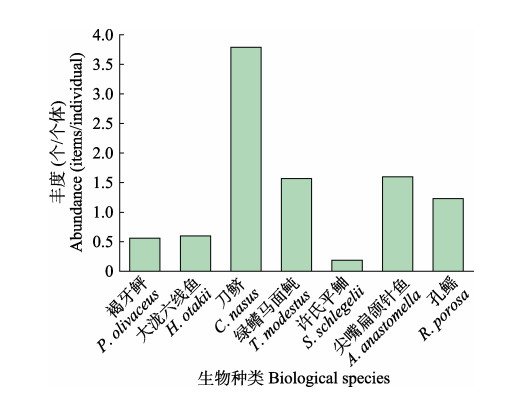
|
图 1 不同海洋鱼类胃肠道内微塑料丰度 Fig.1 Abundance of microplastics in gastrointestinal tract of different marine fish |
本研究表明,长山列岛的野生鱼类普遍受到微塑料的污染,野生鱼类体内胃肠道的微塑料平均丰度为(1.23±1.18)个/个体。Li等(2021)研究表明,在远海太平洋采集的野生鱼类肠道中,微塑料的平均丰度为9.3个/个体;在近岸开放海域如天津近岸沿海海域采集的野生鱼类胃肠道中,平均微塑料丰度为8.8个/个体(韩龙等, 2022);在近岸半封闭海湾北部湾(张帅朋, 2021)中,多鳞
鱼类体内微塑料的形状以纤维为主(图 2和图 3),占比为71.32%,其次为碎片(25.44%)和颗粒(3.26%)。环境中的大型塑料会在光氧化、波浪作用、物理磨损和交替冻融等作用下而破碎,本研究检测到的不同形状微塑料可能源自这些分解的大型塑料。在全球范围内,纤维是目前采集到的野生生物中的主要微塑料形状(表 2),如澳大利亚采集的野生鱼类(Wootton et al, 2021),印度东南沿海采集的贻贝(Mytilus edulis) (Naidu et al, 2019),中国辽河河口采集的软体动物、甲壳类动物以及鱼类中微塑料的主要形状也均为纤维(Wang et al, 2021)。纤维微塑料在生物体内出现率最高,一方面可能是由于海洋环境中纤维微塑料丰度最高;另一方面,可能是由于纤维微塑料可以弯曲或与食物交织,导致其排出较慢,从而增加其生物体内的残留时间(Elizalde et al, 2020)。
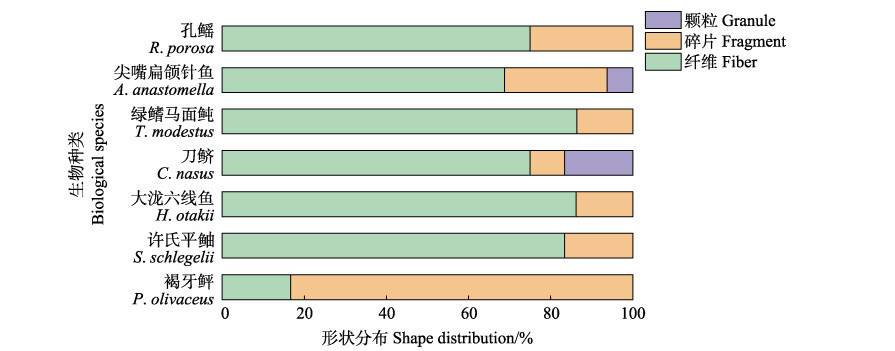
|
图 2 海洋鱼类胃肠道中微塑料的不同形状比例 Fig.2 Different shapes proportions of microplastics in marine fish gastrointestinal tract |

|
图 3 海洋鱼类中典型微塑料 Fig.3 Typical microplastics photos in marine fishes A:纤维;B:碎片;C:颗粒 A: Fiber; B: Fragment; C: Granule |
|
|
表 2 全球范围内海洋鱼类胃肠道中微塑料污染现状 Tab.2 The status of microplastic pollution in marine fish gastrointestinal tract worldwide |
鱼类体内微塑料的颜色分布见图 4。从图 4可以看出,鱼类体内微塑料的颜色大多为透明色(70.25%),丰度最低的颜色为黑色(10.72%)。鱼类胃肠道中微塑料的尺寸分布见图 5。从图 5可以看出,小尺寸的微塑料(< 300 μm)在生物中普遍存在(85.91%),此外,300~500和500~1 000 μm的微塑料占所观察到微塑料分别为7.04%和4.55%,而较大的微塑料(1 000~ 5 000 μm)很少被检测到(2.50%),其原因可能是本次调查采集的鱼类个体尺寸较小,较大尺寸的微塑料不能通过摄食进入鱼类的胃肠道中。
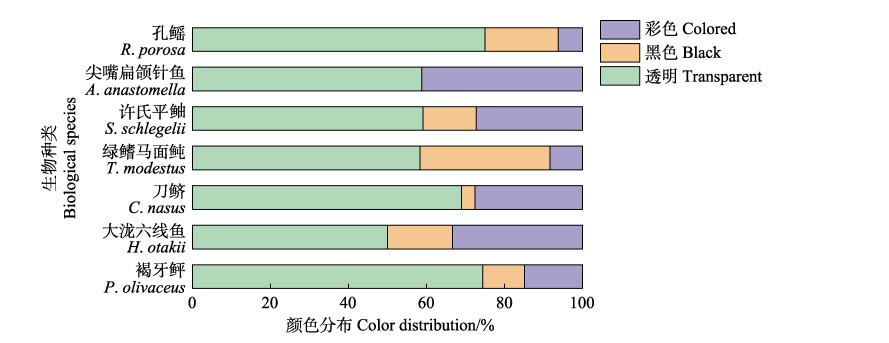
|
图 4 海洋鱼类胃肠道中微塑料的不同颜色比例 Fig.4 Different color proportions of microplastics in marine fish gastrointestinal tract |
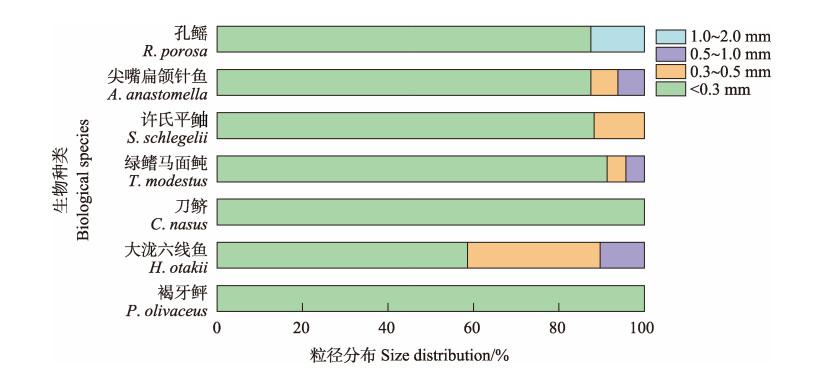
|
图 5 海洋鱼类胃肠道中微塑料的不同粒径比例 Fig.5 Different particle size ratios of microplastics in marine fish gastrointestinal tract |
海洋环境中的微塑料大多粒径较小,尺寸以微米为主(孙承君等, 2022),其颜色、大小和形状与浮游生物相似,可能被鱼类当作猎物而误食(Lusher et al, 2017)。研究表明,海水中的大多数微塑料是透明色和白色,如南黄海(Jiang et al, 2020)和长江口表层(Zhao et al, 2014)水中检测到微塑料大多数为透明色。
通过室内模拟实验发现,鱼类优先捕获黑色微塑料,而对于其他颜色(蓝色、半透明和黄色)的微塑料很少被单独捕食(Xiong et al, 2014)。鱼类能从食物中分辨出不可食用的颗粒,在没有食物的情况下,捕获微塑料颗粒会被吐出,只有当微塑料颗粒与食物混合时,才会最终被鱼类吞食(Ory et al, 2018)。然而,现实海洋环境中,由于受海流、自然风化等各种因素的影响,鱼类摄食不同颜色微塑料的规律性相较于实验室环境弱,导致鱼类摄食的微塑料类型与水体中丰度最高的微塑料颜色相似。
2.3 鱼类胃肠道微塑料的聚合物成分从图 6可以看出,鱼类胃肠道中检测到的聚合物类型为赛璐玢(Cellophane)、纤维素(Cellulose)和聚乙烯(Polyethylene),其中,赛璐玢是最常见的一种聚合物,它也是长山列岛沉积物中最丰富的聚合物成分(图 7)(孙雪梅等, 2022)。赛璐玢是一种有机纤维素基聚合物,常用于食品包装和卷烟包装。它也被用作玻璃纤维和橡胶制品制造中的脱模剂,经常被用作与合成聚合物结合的涂层(Yang et al, 2015)。在本次采集样品中也检测到大量的纤维素,其来源可能包括来自大气沉降的纤维、从污水处理厂的废水中释放的纤维以及污泥在地面应用产生的纤维。此外,在鱼类胃肠道中检测到一定数量的纤维素,它虽然不是一种典型的油基聚合物(如再生纤维素纤维材料:黏胶、莫代尔或莱赛尔),但许多研究发现,这种纤维含量高,不易降解,也视为一种微塑料(Kolbe et al, 2019)。Brate等(2018)研究了来自挪威贻贝中的微塑料,发现纤维素在贻贝中占主导地位。
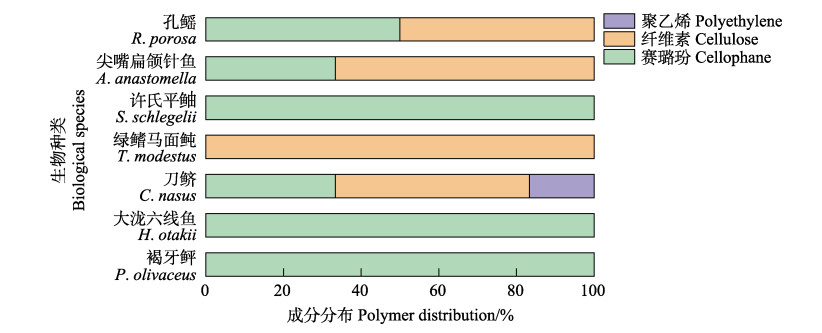
|
图 6 海洋鱼类胃肠道中微塑料的不同成分比例 Fig.6 Different proportion of microplastics in marine fish gastrointestinal tract |
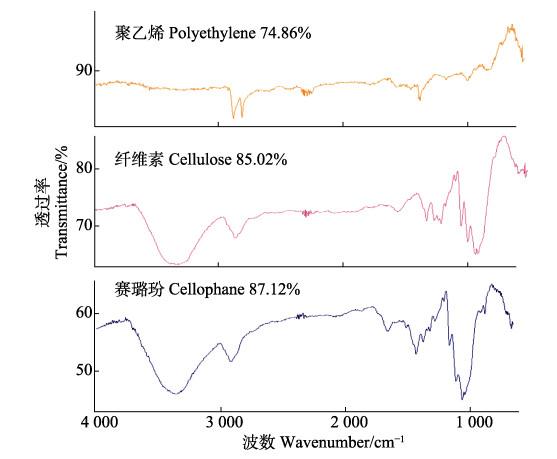
|
图 7 海洋鱼类胃肠道中3种主要微塑料的红外光谱 Fig.7 The μ~FTIR spectra of three main microplastics identified in marine fish gastrointestinal tract 图中的百分比数字为获取的光谱与有机聚合物谱库比对后的匹配度。 The percentage indicates the matching degree of a spectrum obtained with the organic polymer library. |
聚合物危害指数(polymer hazard index, PHI)是目前不同类型微塑料风险评估的重要标准,它主要借助特定聚合物的百分含量和聚合物的危险分数进行生态和健康风险评估(Lithner et al, 2011)。通过聚合物危害指数可以估算出微塑料对人类的潜在风险,聚合物危害指数越高说明该海域生态风险越高。Lithner等(2011)将聚合物毒性系数分为了5个等级,每个危险等级(I~V)增加10倍,即1~10 000,其中,聚乙烯的毒性系数为10,毒性等级为Ⅱ级,危害指数低,属于低等风险聚合物。本研究鱼类体内的微塑料分布主要集中于胃肠道中,肌肉组织中并无微塑料,聚乙烯微塑料仅在刀鲚胃肠道中少量检出,且人们通常会在食用之前丢弃鱼类的胃肠道。因此,长山列岛附近海域的鱼类海产品安全系数较高。
3 结论本研究表明,长山列岛近海域7种海洋野生鱼类胃肠道普遍受到微塑料的污染,体内胃肠道微塑料的丰度范围为0.19~3.79个/个体,鱼类肌肉中并未检测到微塑料。检测到的聚合物类型为赛璐玢、纤维素和聚乙烯,其中,纤维素和赛璐玢对生物体无明显毒性作用,聚乙烯聚合物的危害指数较低。因此,长山列岛水域微塑料的存在暂时不会对其鱼类的食品质量安全构成威胁。通过与其他类型近海区域相比,长山列岛近海鱼类胃肠道内的微塑料丰度处于较低水平,未来还应加强研究其他野生生物体如贝类等经济生物可食用部分的微塑料分布情况,从而为长山列岛海域微塑料的污染水平分析和防控策略制定提供科学依据。
ANDRES C, ELISA M, CARLOS M, et al. The Arctic Ocean as a dead end for floating plastics in the North Atlantic branch of the thermohaline circulation. Science Advances, 2017, 3(4): 1600582 DOI:10.1126/sciadv.1600582 |
BRATE I L N, HURLEY R, IVERSEN K, et al. Mytilus spp. as sentinels for monitoring microplastic pollution in Norwegian coastal waters: A qualitative and quantitative study. Environmental Pollution, 2018, 243(Pt A): 383-393 |
BROWNE M A, DISSANAYAKE A, GALLOWAY T S, et al. Ingested microscopic plastic translocates to the circulatory system of the mussel, Mytilus edulis (L). Environmental Science and Technology, 2008, 42(13): 5026-5031 DOI:10.1021/es800249a |
CAI H W, DU F N, ZHANG W W, et al. Research progress of microplastics and nanoplastics in environment. Research of Environmental Sciences, 2021, 34(11): 2547-2555 [蔡慧文, 杜方旎, 张微微, 等. 环境微纳塑料的分析方法进展. 环境科学研究, 2021, 34(11): 2547-2555] |
CHEN M, DU M, JIN A, et al. Forty-year pollution history of microplastics in the largest marginal sea of the western Pacific. Geochemical Perspectives Letters, 2020, 13: 42-47 |
CHEN X, ZHANG J N, WEI H. Research progress and prospect on transportation, transformation and ecotoxicology of microplastics in environment. Asian Journal of Ecotoxicology, 2021, 16(6): 70-86 [陈璇, 章家恩, 危晖. 环境微塑料的迁移转化及生态毒理学研究进展. 生态毒理学报, 2021, 16(6): 70-86] |
CHIARA G, SILVIA M, SARA F, et al. Effects of polystyrene microbeads in marine planktonic crustaceans. Ecotoxicology and Environmental Safety, 2017, 145: 250-257 DOI:10.1016/j.ecoenv.2017.07.036 |
ELIZALDE V A, CARCANO A M, CRAGO J, et al. Translocation, trophic transfer, accumulation and depuration of polystyrene microplastics in Daphnia magna and Pimephales promelas. Environmental Pollution, 2020, 259: 113937 DOI:10.1016/j.envpol.2020.113937 |
ERIKSEN M, LEBRETON L C M, CARSON H S, et al. Plastic pollution in the world' s oceans: More than 5 trillion plastic pieces weighing over 250, 000 tons afloat at sea. PLoS One, 2014, 9: 1-15 |
FADIYAH M B, EL-JAWAHER A B D, MANAL E A E, et al. Microplastic in the gastrointestinal tract of fishes along the Saudi Arabian Red Sea coast. Marine Pollution Bulletin, 2018, 131(PtA): 407-415 |
HAN L, LV H R, HAN T, et al. Distribution characteristics and pollution risk of microplastics in Tianjin coastal waters. Periodical of Ocean University of China (Natural Science), 2022, 52(8): 124-131 [韩龙, 吕浩然, 韩彤, 等. 天津近岸海域微塑料分布特征及污染风险评价. 中国海洋大学学报(自然科学版), 2022, 52(8): 124-131] |
HOSSEINPOUR A, CHAMANI A, MIRZAEI R, et al. Occurrence, abundance and characteristics of microplastics in some commercial fish of northern coasts of the Persian Gulf. Marine Pollution Bulletin, 2021, 171(10): 112693 |
HUANG J, KOONGOLLA J B, LI H, et al. Microplastic accumulation in fish from Zhanjiang mangrove wetland, South China. Science of the Total Environment, 2020, 708(C): 134839 |
ILIUM L, DAVIS S S, WILSON C G, et al. Blood clearance and organ deposition of intravenously administered colloidal particles: The effects of particle size, nature and shape. International Journal of Pharmaceutics, 1982, 12(2/3): 135-146 |
JIA F. Don't let plastic garbage become human-being's "heritage". World Environment, 2019(6): 1 [贾峰. 不要让塑料垃圾成为人类的"遗产". 世界环境, 2019(6): 1] |
JIANG Y, ZHAO Y, WANG X, et al. Characterization of microplastics in the surface seawater of the South Yellow Sea as affected by season. Science of the Total Environment, 2020, 724: 138375 DOI:10.1016/j.scitotenv.2020.138375 |
JOVANOVIC B. Ingestion of microplastics by fish and its potential consequences from a physical perspective. Integrated Environmental Assessment and Management, 2017, 13(3): 510-515 DOI:10.1002/ieam.1913 |
KEENAN M, HELM P A, JACKSON D A, et al. Impacts of temperature and selected chemical digestion methods on microplastic particles. Environmental Toxicology and Chemistry, 2018, 37(1): 91-98 DOI:10.1002/etc.3935 |
KIM I S, CHAE D H, KIM S K, et al. Factors influencing the spatial variation of microplastics on high-tidal coastal beaches in Korea. Archives of Environmental Contamination and Toxicology, 2015, 69(3): 299-309 DOI:10.1007/s00244-015-0155-6 |
KOLBE S, CAO C Z. Microplastic or microfibrs? The conceptual confusion. Melliand China, 2019, 47(7): 56 [Kolbe S, 曹传枝. 令人困惑的微塑料颗粒或微纤维概念. 国际纺织导报, 2019, 47(7): 56 DOI:10.3969/j.issn.1007-6867.2019.07.016] |
LI W W, PAN Z, XU J, et al. Microplastics in a pelagic dolphinfish (Coryphaena hippurus) from the Eastern Pacific Ocean and the implications for fish health. Science of the Total Environment, 2021, 809: 151126 |
LITHNER D, LARSSON A, DAVE G. Environmental and health hazard ranking and assessment of plastic polymers based on chemical composition. Science of the Total Environment, 2011, 409(18): 3309-3324 DOI:10.1016/j.scitotenv.2011.04.038 |
LU Y, ZHANG Y, DENG Y, et al. Uptake and accumulation of polystyrene microplastics in zebra fish (Danio rerio) and toxic effects in liver. Environmental Science and Technology, 2016, 50(7): 4054-4060 DOI:10.1021/acs.est.6b00183 |
LUCIA G, LUIS R V, DIOGO R, et al. Uptake and effects of the antimicrobial florfenicol, microplastics and their mixtures on freshwater exotic invasive bivalve Corbicula fluminea. Science of the Total Environment, 2018(1): 1134-1142 |
LUIS G A B, CLARA L, PATRICIA O, et al. Microplastics in wild fish from North East Atlantic Ocean and its potential for causing neurotoxic effects, lipid oxidative damage, and human health risks associated with ingestion exposure. Science of the Total Environment, 2020, 717: 134625 DOI:10.1016/j.scitotenv.2019.134625 |
LUSHER A L, MCHUGH M, THOMPSON R C. Occurrence of microplastics in the gastrointestinal tract of pelagic and demersal fish from the English Channel. Marine Pollution Bulletin, 2013, 67(1/2): 94-99 |
LUSHER A L, WELDEN N A, SOBRAL P, et al. Sampling, isolating and identifying microplastics ingested by fish and invertebrates. Analytical Methods, 2017, 9(9): 1346-1360 DOI:10.1039/C6AY02415G |
NAIDU S A. Preliminary study and first evidence of presence of microplastics and colorants in green mussel, Perna viridis (Linnaeus, 1758), from southeast coast of India. Marine Pollution Bulletin, 2019, 140: 416-422 DOI:10.1016/j.marpolbul.2019.01.024 |
NIE H Y, WANG J, XU K H, et al. Microplastic pollution in water and fish samples around Nanxun Reef in Nansha Islands, South China Sea. Science of the Total Environment, 2019, 696(C): 134022 |
ORY N C, GALLARDO C, LENZ M, et al. Capture, swallowing, and egestion of microplastics by a planktivorous juvenile fish. Environmental Pollution, 2018, 240: 566-573 DOI:10.1016/j.envpol.2018.04.093 |
PAN Z, GUO H G, CHEN H Z, et al. Microplastics in the Northwestern Pacific: Abundance, distribution, and characteristics. Science of the Total Environment, 2018, 650(Pt 2): 1913-1922 |
PAN Z, LIU Q L, JIANG R G, et al. Microplastic pollution and ecological risk assessment in an estuarine environment: The Dongshan Bay of China. Chemosphere, 2021, 262: 127876 DOI:10.1016/j.chemosphere.2020.127876 |
QIAO R X, SHENG C, LU Y F, et al. Microplastics induce intestinal inflammation, oxidative stress, and disorders of metabolome and microbiome in zebrafish. Science of the Total Environment, 2019, 662: 246-253 DOI:10.1016/j.scitotenv.2019.01.245 |
SAMANEH K, ABOLFAZL G, HAZILAWATI B H, et al. Abundance and characteristics of microplastics in commercial marine fish from Malaysia. Marine Pollution Bulletin, 2019, 148: 5-15 DOI:10.1016/j.marpolbul.2019.07.072 |
SAYED A E H, HAMED M, BADREY A E A, et al. Microplastic distribution, abundance, and composition in the sediments, water, and fishes of the Red and Mediterranean seas, Egypt. Marine Pollution Bulletin, 2021, 173: 112966 DOI:10.1016/j.marpolbul.2021.112966 |
SIDDIQUE M A M, UDDIN A, RAHMAN S M A, et al. Microplastics in an anadromous national fish, Hilsa shad Tenualosa ilisha from the Bay of Bengal, Bangladesh. Marine Pollution Bulletin, 2022, 174: 113236 DOI:10.1016/j.marpolbul.2021.113236 |
SILVIA M, SILVIA M, MARCO P, et al. Effects of polystyrene microplastics on early stages of two marine invertebrates with different feeding strategies. Environmental Pollution, 2018, 237: 1080-1087 DOI:10.1016/j.envpol.2017.11.030 |
STEFATOS A, CHARALAMPAKIS M, PAPATHEODOROUG, et al. Marine debris on the seafloor of the Mediterranean Sea: Examples from two enclosed gulfs in western Greece. Marine Pollution Bulletin, 1999, 38(5): 389-393 DOI:10.1016/S0025-326X(98)00141-6 |
SU L, DENG H, LI B W, et al. The occurrence of microplastic in specific organs in commercially caught fishes from coast and estuary area of east China. Journal of Hazardous Materials, 2018, 365: 716-724 |
SUN C J, DIND J F, GAO F L, et al. Challenges and perspectives of marine microplastic research. Advances in Marine Science, 2022, 40(4): 717-724 [孙承君, 丁金凤, 高丰蕾, 等. 海洋微塑料研究挑战与展望. 海洋科学进展, 2022, 40(4): 717-724] |
SUN X M, MENG D, ZHENG Y X, et al. Distribution characteristics of microplastics in sedimentary environment of adjacent sea area of Changshan Islands. Acta Hydrobiologica Sinica, 2022, 44(2): 39-45 [孙雪梅, 孟迪, 郑言鑫, 等. 长山列岛邻近海域沉积环境微塑料的分布特征. 水生生物学报, 2022, 44(2): 39-45] |
SUN X X, LI Q J, SHI Y Q, et al. Characteristics and retention of microplastics in the digestive tracts of fish from the Yellow Sea. Environmental Pollution, 2019, 249: 878-885 DOI:10.1016/j.envpol.2019.01.110 |
TENG J. Microplastic pollution in Laizhou Bay and its ecotoxic effects on typical bivalves. Doctoral Dissertation of University of Chinese Academy of Sciences (Yantai Coastal Zone Research Institute, Chinese Academy of Sciences), 2021 [滕佳. 莱州湾微塑料污染特征及其对典型双壳贝类生态毒性效应研究. 中国科学院大学(中国科学院烟台海岸带研究所)博士研究生学位论文, 2021]
|
WANG F F, WU H W, WU W N, et al. Microplastic characteristics in organisms of different trophic levels from Liaohe Estuary, China. Science of the Total Environment, 2021, 789: 148027 DOI:10.1016/j.scitotenv.2021.148027 |
WANG J, WANG M, RU S, et al. High levels of microplastic pollution in the sediments and benthic organisms of the South Yellow Sea, China. Science of the Total Environment, 2018, 651(2): 1661-1669 |
WANG Q, ZHU X, HOU C, et al. Microplastic uptake in commercial fishes from the Bohai Sea, China. Chemosphere, 2021, 263: 127962 DOI:10.1016/j.chemosphere.2020.127962 |
WANG W, XU G L. Plastic and microplastic pollution in the Oceans. Technology Wind, 2019(13): 123-126 [王维, 徐桂亮. 海洋中的塑料和微塑料污染. 科技风, 2019(13): 123-126] |
WOOTTON N, FERREIRA M, REIS S P, et al. A comparison of microplastic in fish from Australia and Fiji. Frontiers in Marine Science, 2021, 8: 690991 DOI:10.3389/fmars.2021.690991 |
XIONG X, TU Y N, CHEN X C, et al. Ingestion and egestion of polyethylene microplastics by goldfish (Carassius auratus): Influence of color and morphological features. Heliyon, 2019, 5(12): e03063 DOI:10.1016/j.heliyon.2019.e03063 |
YANG D Q, SHI H H, LI L, et al. Microplastic pollution in table salts from China. Environmental Science & Technology, 2015, 49(22): 13622-13627 |
YIN L Y, CHEN B J, XIA B, et al. Polystyrene microplastics alter the behavior, energy reserve and nutritional composition of marine jacopever (Sebastes schlegelii). Journal of Hazardous Materials, 2018, 360: 97-105 DOI:10.1016/j.jhazmat.2018.07.110 |
YU X, XU L L, LIU Q, et al. A bundance, shape, and chemical composition of microplastics within ten common marine species in Xiangshan Bay. Progress in Fishery Sciences, 2021, 42(4): 9-18 [于翔, 许莉莉, 刘强, 等. 象山湾常见海洋生物体内微塑料的丰度、形态和成分组成研究. 渔业科学进展, 2021, 42(4): 9-18] |
ZENG Y P, JI R, SHI H H, et al. Introduction to environmental microplastics. Beijing: Science Press, 2020: 4-28 [曾永平, 季荣, 施华宏, 等. 环境微塑料概论. 北京: 科学出版社, 2020: 4-28]
|
ZHANG D, CUI Y, ZHOU H, et al. Microplastic pollution in water, sediment, and fish from artificial reefs around the Ma'an Archipelago, Shengsi, China. Science of the Total Environment, 2020, 703: 134768 DOI:10.1016/j.scitotenv.2019.134768 |
ZHANG F, XU J Y, ZHU L X, et al. Seasonal distributions of microplastics and estimation of the microplastic load ingested by wild caught fish in the East China Sea. Journal of Hazardous Materials, 2021, 419: 126456 DOI:10.1016/j.jhazmat.2021.126456 |
ZHANG S P. Characteristics of microplastic pollution in typical organisms of the manfrove wetland in Beibu Gule. Master's Thesis of Guangxi University, 2021 [张帅朋. 北部湾红树林湿地中典型生物体内微塑料污染特征研究. 广西大学硕士研究生学位论文, 2021]
|
ZHAO J. Research progress on plastics waste recycling. Modern Plastics Processing and Applications, 2020, 32(4): 60-63 [赵娟. 废塑料回收利用的研究进展. 现代塑料加工应用, 2020, 32(4): 60-63] |
ZHAO P Q, WU Z F, DONG S J, et al. Research progress of contamination and toxic effects of microplastics in fish based on a statistical analysis of patterns of publications. Asian Journal of Ecotoxicology, 2022, 17(2): 43-63 [赵培强, 吴志丰, 董四君, 等. 基于文献计量方法的微塑料在鱼体中的污染现状及毒性效应研究进展. 生态毒理学报, 2022, 17(2): 43-63] |
ZHAO S, ZHU L, WANG T, et al. Suspended microplastics in the surface water of the Yangtze estuary system, China: First observations on occurrence, distribution. Marine Pollution Bulletin, 2014, 86(1/2): 562-568 |
ZHU L, WANG H, CHEN B J, et al. Microplastic ingestion in deep-sea fish from the South China Sea. Science of the Total Environment, 2019, 677: 493-501 |
ZOU J Y, XUE Y, JI Y P, et al. Spatio-temporal variations in species composition and diversity of fish communities in the adjacent waters of Changshan Islands China. Chinese Journal of Applied Ecology, 2022, 33(8): 2237-2243 [邹建宇, 薛莹, 纪毓鹏, 等. 长山列岛邻近海域鱼类群落种类组成和多样性时空变化. 应用生态学报, 2022, 33(8): 2237-2243] |




 Eastern keelback mullet
Eastern keelback mullet S. sihama
S. sihama 虎鱼Chaeturichthys stigmatias
虎鱼Chaeturichthys stigmatias